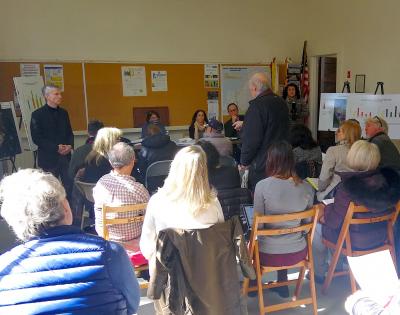Water Tests Point to Contamination at Sand Land Mine

People showed up in force at the Old Noyac Schoolhouse on Friday to hear the results of groundwater tests that were conducted at the Sand Land mine on the Noyac-Bridgehampton border.
Among those speaking at the meeting, which was hosted by the Noyac Civic Council, were Robert DeLuca, president of the Group for the East End, Adrienne Esposito of the Citizens Campaign for the Environment, and Stuart Z. Cohen, Ph.D., from Environmental and Turf Services of Wheaton, Md.
Dr. Cohen, an organic chemist and certified groundwater professional, analyzed the raw data collected from the test wells placed by the Suffolk County Health Department.
According to Dr. Cohen, the preliminary findings indicate the presence of abnormally high concentrations of nitrate, manganese, and cobalt in the aquifer below the mine, and lead, arsenic, and manganese in the surface water. He attributed the contamination not only to the above-ground dumping of waste into the mine, but also to the mobilization of naturally present subsurface heavy metals that are released as a consequence of contaminated flow-through.
The Sand Land Corporation, also known as Wainscott Sand and Gravel, which operates the mine, has been using it for composting and mulching operations since running out of sand to mine decades ago. That use has been the focus of several legal actions in recent years, as has an application to expand mining operations there to cover an additional 4.9 acres and an additional 40 feet of depth.
The Sand Lane mine, which covers some 50 acres, is in one of the county's six special groundwater protection areas.
“Everybody understands the value of this particular geographic space to our drinking water,” Mr. DeLuca told the crowd on Friday. “For 30 years, every level of government has worked to make this part of our town a special groundwater protection area under state law, a critical environmental area under county law, and an aquifer protection overlay district under town law.”
He said the New York State Department of Environmental Conservation was made aware of the improper use of the site for composting and mulching and of the environmental risks involved in large-scale mulching projects.
“They were told that underneath these types of operations we have the mobilization of heavy metals, radioactive activity, in some cases pesticides. We are liberating toxins we don't want to have in our drinking water,” Mr. DeLuca said.
When Sand Land wanted to expand and get new permits for industrial waste processing, the D.E.C. was asked to look at the impact of the Sand Land operation on the water underneath the mine.
“We were ignored,” Mr. DeLuca said. “Over and over again. Those arguments were made in writing and made in person. They did nothing. The frustrating thing is that the contamination has been there while we've spent years trying to get at the data.”
He and his fellow panelists called for the state to step in to characterize the extent of the contamination, get rid of the material causing the pollution, and prevent the Sand Land operation from continuing.
“The agency that is responsible and that needs to be held accountable is the State of New York, which knew for close to a decade that this was a risk and did nothing about it,” said Mr. DeLuca. “The state cannot continue to say that a mining operation that has a pile of compost as high as this room is somehow in the process of reclaiming the facility, and that therefore this is not a problem. It is a problem. At the end of the day it is a reservoir, not a landfill, and we have to start treating it that way.”
A staffer from Representative Lee Zeldin's office was in attendance on Friday. Assemblyman Fred W. Thiele Jr. was not at the meeting, but in a press release that day, he said, "For more than five years I have expressed my concerns to government regulators at all levels about the environmental threat presented by the various industrial operations being undertaken by Sand Land at its Noyac location."
He faulted the D.E.C. for turning "a blind eye to these community concerns," and said, "Years of regulatory neglect have yielded a stew of contamination that would more likely be associated with an open dump than a legitimate business."
A second meeting on the water data was to be held on Tuesday at 7:30 p.m., also at the Old Noyac Schoolhouse at 3010 Noyac Road, although an impending storm may force a rescheduling. Other public meetings across the South Fork on Tuesday have already been rescheduled.
